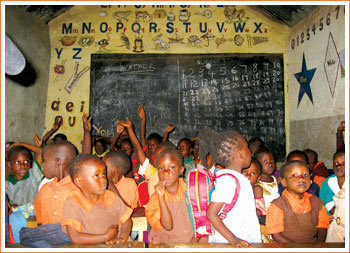Idaho 4-H helps Africa orphans
In the unimaginable squalor of Nairobi’s Kibera slum lies the Magoso Center. Kenyan orphans and desperately poor children get basic education, vocational skills, and life-sustaining meals.

Photo©LINDA MORRIS
Participants in the Western Regional 4-H Leaders’ Forum in Boise recently gave $1,000 to the school visited in 2007 by CALS students addressing Kenyan water-quality issues. See story and video in prior issue
State 4-H specialist Linda Webb is adopting it as a global ser vice project. 4-H’ers pledge to serve their “club, community, country, and world. If everybody gives a dollar, just imagine the difference,” Webb said. A total $4,500 funds lunch for 200 Magoso students for a year.
TO CONTRIBUTE, call Linda Webb at 208.364.4004 or visit www.4h.uidaho.edu.
More background/details
Giving back to one’s community is “part of the DNA of 4-H,” says Don Floyd, president and chief executive officer of the National 4-H Council. In fact, young people who are engaged in 4-H are six times more likely to engage in their communities than young people in other organizations, according to a Tufts University study.
Now, we live in a global community.
“Literally everything that happens in American communities is impacted by what happens in some other part of the world,” Floyd says. “It makes sense for young people to understand that interdependence, and preparing them to be part of a global society has become really, really important.”
It makes sense to Linda Webb, too. The University of Idaho 4-H specialist had long sought to connect Idaho’s 4-H community with an international service project. After video specialist Brad Beckman returned from Kenya, where he had filmed College of Agricultural and Life Sciences students participating in water-quality projects, the link was forged.
Watching Beckman’s video of the orphaned and vulnerable school children at the MAGOSO Centre in Nairobi’s Kibera slum, Webb thought, “Why not this?”
She seized the opportunity to launch a fundraising campaign at the Western Regional 4-H Leaders’ Forum, which raised nearly $1,000 for the primary and pre-primary school in March, and developed a far more ambitious “challenge” for Idaho’s Teen Conference in June.
Just $1.75 will feed a child at the MAGOSO Centre for a week, and $75 will cover a teacher’s expenses for the month, Webb says. A little over $30 a year will allow a child to continue his or her secondary education at a district school, and $455 will provide annual tuition at a provincial school.
More about the Kenya orphanage/school
About 200 young Kenyans attend the MAGOSO Centre, most of whom have lost one or both parents to HIV/AIDS. At the Eric and Faye Morris Development Group, which supports sustainable African projects, including MAGOSO, Eric Morris describes the children’s circumstances as “the bottom tier of the bottom tier.”
“The whole point of the school is to give them enough primary and vocational education so that they can escape the slum,” he says. “A MAGOSO education doesn’t guarantee them a future, but it gives them a chance.”
“Africa cuts the legs from under your world view,” says Morris, who has paid $10 for a child’s life-saving medication. “A small amount of money can make such a big difference in a life that you can’t reach into your pocket fast enough.”
“4-H’ers pledge to serve their “club, community, country, and world,” Webb says “If everybody gave a dollar, just imagine the difference that would make.”
Text by MARLENE FRITZ
|